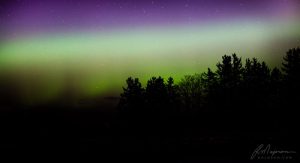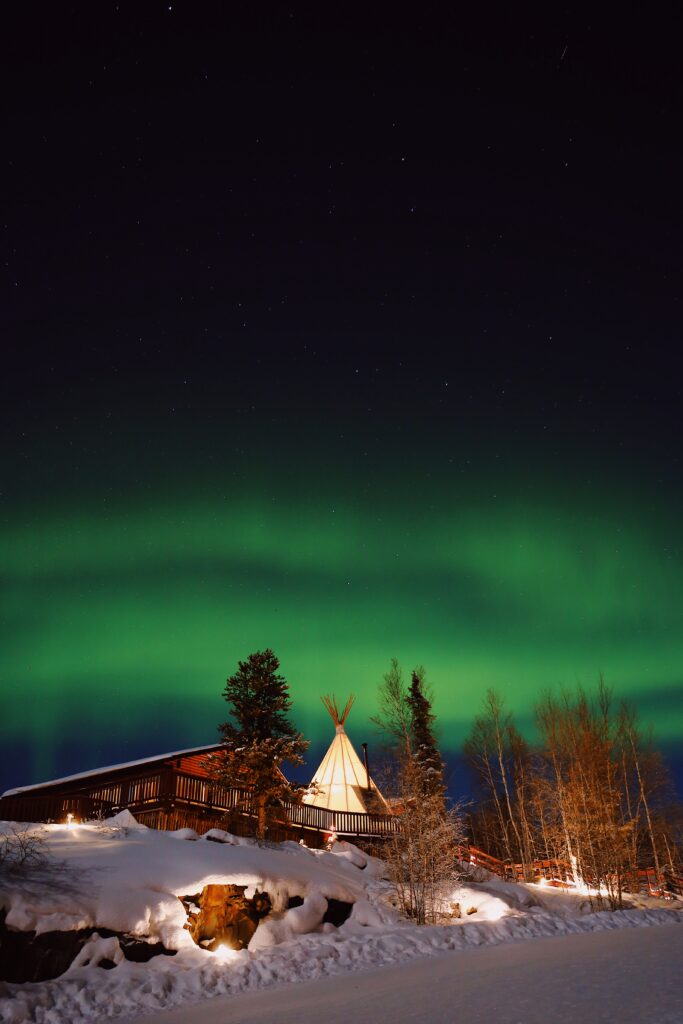
People & Culture
How to photograph the northern lights at lower latitudes
This photog lives in southern Ontario, but still gets amazing photos of the northern lights. Here’s how.
- 1777 words
- 8 minutes
Travel
With solar activity expected to peak in 2024, there’s never been a better time to see the northern lights. Here’s how to do it in the “aurora capital of North America.”

“She’s here.”
I’ve just shrugged off my heavy parka inside a rustic cabin on the outskirts of Yellowknife when Tracy Therrien bursts through the door to announce the arrival of a highly-anticipated guest: the aurora borealis.
I scramble back into my gear, heart beating fast, and head out into the -23 C night. Arcing across the starry sky above the roof of the cabin is what looks like a broad jet of pale grey vapour. But my camera reveals a telltale green: Lady Aurora has indeed decided to make an appearance. Over the next hour, she flows and broadens, filling the sky with imperceptible colour. Then, suddenly, she starts to dance, ribbons of now-visible green coiling and snapping, flaring and fading. I keep a finger poised on my camera’s shutter, the cold and my fatigue utterly forgotten.
As suddenly as she appeared, she’s gone, and I retreat inside the cabin for a midnight snack of Therrien’s homemade fish chowder and bannock. As my fingers and face thaw by the warmth of the wood stove, I ask Therrien — my host from Bucket List Tours — why she refers to the aurora borealis using feminine pronouns. She shrugs; aside from the fact that Aurora was named for the Roman goddess of the dawn, such a mercurial phenomenon could only be a woman: “She’s an extension of Mother Earth. She’s magnificent, she’s powerful, and she’s 100 per cent unpredictable.”


Unpredictable she may be, but if you’ve long dreamed of seeing the northern lights for yourself, experts say 2024 is your best chance in a decade. Auroras occur when charged particles blasted out by the sun strike Earth’s magnetic field and interact with gases in the upper atmosphere, producing flashes of visible light. The more solar activity, the more intense and colourful the auroras appear — and it just so happens that the sun is currently heading into a peak in its roughly 11-year activity cycle. Although visible auroras have been spotted as far south as 40 degrees latitude during periods of intense solar activity, the best and most reliable viewing tends to happen within a broad zone between 60 and 75 degrees. Canadian cities within this auroral zone include Whitehorse, Iqaluit and, of course, Yellowknife, where I see auroras on two out of three nights.
Unsurprisingly, as word of the uptick in solar activity has gotten around, interest in travelling to see auroras has increased. Read on for tips to plan your own waltz with Lady Aurora in the Northwest Territories capital, and be sure to check out Expedia’s comprehensive travel guide to other top aurora borealis viewing locations around the world, including Reykjavik, Iceland, Tromsø, Norway, and Churchill, Man.

With wide-open skies, little light pollution and auroras visible up to 240 nights per year, Yellowknife is one of the best places in North America to see the northern lights. It’s also surprisingly accessible, with daily direct flights to and from Vancouver, Calgary, Edmonton and Toronto.
Self-guided aurora viewing is possible at several viewpoints in and around the city (pick up a map in any hotel lobby), but the experience is richer with a knowledgeable host like Therrien — and having someplace nearby to warm up when the sky doesn’t cooperate is a definite plus.
A night at the Indigenous owned and operated Aurora Village is an experience unto itself, whether auroras show up or not. Guests are bused 25 minutes to the village from the capital, then shown to their private, heated tipi, where a selection of complimentary hot drinks awaits. If and when the auroras show, roving guides will let you know — but the excited shouts of other guests are also a good sign to snowsuit up and head outside. A nightly demonstration of how quickly ramen noodles freeze at temperatures below -20 C is cheesy but good fun for visitors who have never experienced the subarctic cold, and for an extra fee, you can reserve yourself a heated seat on an elevated viewing platform to take in the sky show in comfort.
If you can, spend a few minutes chatting with Arvin Landry. When not running around feeding the wood stoves in the tipis, he can often be found on the deck outside the main dining hall, singing songs of gratitude and encouragement to the steady beat of his hand drum. As a child, Landry, who is Dene from Fort Providence, N.W.T, was taught that the auroras are the spirits of departed loved ones: “It’s our relatives dancing for us, letting us know they’re still with us.”
Landry now shares this teaching with guests, to help them connect to the spectacle on a deeper level. “Allow yourself to breathe and get grounded, and the auroras will show you something you thought was gone,” he says.

The long northern winter night means more hours for aurora viewing, but it is cold. Nighttime lows of -20 C and below are the norm and the wind can make it feel even colder. Several thermal layers and insulated outerwear are a must to avoid hypothermia and frostbite. Worried your usual winter gear isn’t up to the task? Many local outfitters and aurora tour companies rent Arctic-rated clothing, including boots, mitts, overalls, parkas and hats. This video offers helpful tips for dressing, but when in doubt, just add another layer — it’s better to take something off if you overheat than shiver your way through a bucket-list experience.
It’s a fact: the cold makes you hungry. Fortunately, Yellowknife has no shortage of great places to put away a hearty meal — and sample the bounty of Great Slave Lake, North America’s deepest lake. The Woodyard Brewhouse at NWT Brewing Company in Old Town is a happening night spot offering pub favourites and a wide range of beers crafted in-house. For an upscale experience with a northern twist, head to Copperhouse. Be sure to try the ceviche made with Great Slave Lake whitefish and, to drink, the extremely on-brand “3 O’Clock Sunset,” a local take on sangria.
There’s no better feeling than falling into your warm bed at 2 a.m. with visions of auroras dancing in your head. The Explorer Hotel in downtown Yellowknife is clean, comfortable and quiet. It’s also a pickup point for many aurora tours and other excursions, letting you transition seamlessly between adventures and get the rest you need. The onsite Traders Grill offers a hot breakfast buffet until 11 a.m. five days a week and a breakfast menu until 2 p.m. on Saturdays, so you can sleep late and fuel up for another day (and night) of fun.

What if Lady Aurora doesn’t show?* There are plenty of other ways to have a memorable time in Yellowknife. Head to Aurora Village in the daytime to enjoy tubing, marshmallows toasted over an open fire, and a snowshoe walk through snow-dusted spruce, where your Dene guide will share the traditional uses of various boreal plants and demonstrate how to start a fire on the snow using birchbark and “fuzzy sticks” (spruce branches covered in lichen). Or, get your adrenaline pumping with a ride across a frozen lake in a sled pulled by a team of extremely energetic dogs. North of 60 Aurora Adventures offers dog-sledding packages that include a half-hour ride on a secluded trail, followed by hot drinks and bannock in their heated tipi or trapper’s cabin.
*She will. If you spend three nights in Yellowknife during peak aurora season (mid-August to the end of September, and mid-November to early April), you have a 98 per cent chance of seeing the northern lights at least once.
Are you passionate about Canadian geography?
You can support Canadian Geographic in 3 ways:

People & Culture
This photog lives in southern Ontario, but still gets amazing photos of the northern lights. Here’s how.

Science & Tech
For scientists and northern lights rubberneckers, 2013 promises to be a once-in-a-decade opportunity to experience the sun’s magnetic power at its height.

Travel
After years of waiting to see the aurora borealis, Robin Esrock recounts his experience viewing these dancing lights with his father in Yellowknife

Science & Tech
Shiny auroras will fly farther south over the next 18 months